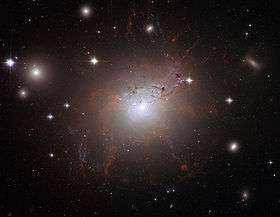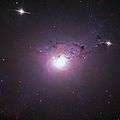NGC 1275
NGC 1275 (also known as Perseus A or Caldwell 24) is a type 1.5 Seyfert galaxy[3] located around 237 million light-years away[2] in the direction of the constellation Perseus. NGC 1275 corresponds to the radio galaxy Perseus A and is situated near the center of the large Perseus Cluster of galaxies.
| NGC 1275 | |
|---|---|
 Hubble Space Telescope image of NGC 1275 | |
| Observation data (J2000 epoch) | |
| Constellation | Perseus |
| Right ascension | 03h 19m 48.1s[1] |
| Declination | +41° 30′ 42″[1] |
| Redshift | 5264 ± 11 km/s[1] z=0.017559[1] |
| Distance | 222 million light-years 68.2 Mpc[2] |
| Group or cluster | Perseus Cluster |
| Apparent magnitude (V) | 12.6[1] |
| Characteristics | |
| Type | cD;pec;NLRG[1] |
| Apparent size (V) | 2′.2 × 1′.7[1] |
| Other designations | |
| Perseus A,[1] PGC 12429,[1] UGC 2669,[1] QSO B0316+413, Caldwell 24, 3C 84[1] | |
Properties

NGC 1275 consists of two galaxies, a central type-cD galaxy in the Perseus Cluster, and a so-called "high velocity system" (HVS) which lies in front of it. The HVS is moving at 3000 km/s[4] towards the dominant system, and is believed to be merging with the Perseus Cluster. The HVS is not affecting the cD galaxy as it lies at least 200 thousand light years from it.[5] however tidal interactions are disrupting it and ram-pressure stripping produced by its interaction with the intracluster medium of Perseus is stripping its gas as well as producing large amounts of star formation within it[6]
The central cluster galaxy contains a massive network of spectral line emitting filaments,[7] which apparently are being dragged out by rising bubbles of relativistic plasma generated by the central active galactic nucleus.[8] Long gaseous filaments made up of threads of gas stretch out beyond the galaxy, into the multimillion-degree, X-ray–emitting gas that fills the cluster. The amount of gas contained in a typical thread is approximately one million times the mass of the Sun. They are only 200 light-years wide, are often very straight, and extend for up to 20,000 light-years.[9]
The existence of the filaments poses a problem. As they are much cooler than the surrounding intergalactic cloud, it is unclear how they have existed for such a long time, or why they have not warmed, dissipated or collapsed to form stars.[10][11] One possibility is that weak magnetic fields (about one-ten-thousandth the strength of Earth's field) exert enough force on the ions within the threads to keep them together.[10][11]
NGC 1275 contains 13 billion solar masses of molecular hydrogen that seems to be infalling from Perseus' intracluster medium in a cooling flow, both feeding its active nucleus[12] and fueling significant amounts of star formation[13]
The presence of an active nucleus demonstrates that a supermassive black hole is present in NGC 1275's center. The black hole is surrounded by a rotating disk of molecular gas.[14] High-resolution observations of the rotation of this disk obtained using adaptive optics at the Gemini North telescope indicate a central mass of approximately 800 million Solar masses, including both the mass of the black hole and of the inner core of the gas disk.[15]
Gallery
 NGC 1275 multi-wavelength composite
NGC 1275 multi-wavelength composite Hubble Space Telescope 1.73′ view of NGC 1275
Hubble Space Telescope 1.73′ view of NGC 1275 Wide multi-wavelength composite view of NGC 1275 and the center of the Perseus Cluster (VLA-Radio, Chandra-X-ray, Hubble-Visible, SDSS-Infrared)
Wide multi-wavelength composite view of NGC 1275 and the center of the Perseus Cluster (VLA-Radio, Chandra-X-ray, Hubble-Visible, SDSS-Infrared)
References
- "NASA/IPAC Extragalactic Database". Results for NGC 1275. Retrieved 2006-11-19.
- "Distance Results for NGC 1275". NASA/IPAC Extragalactic Database. Retrieved 2010-03-31.
- Ho, Luis C.; Filippenko, Alex V.; Sargent, Wallace L. W. (October 1997). "A Search for "Dwarf" Seyfert Nuclei. III. Spectroscopic Parameters and Properties of the Host Galaxies". Astrophysical Journal Supplement. 112 (2): 315–390. arXiv:astro-ph/9704107. Bibcode:1997ApJS..112..315H. doi:10.1086/313041.
- Minkowski R., 1957, in IAU Symp 4, Radio astronomy, p107
- Gillmon K., Sanders J.S., Fabian A.C., An X-ray absorption analysis of the high-velocity system in NGC 1275, 2004, MNRAS, 348, 159
- Gallagher, John S., III; Lee, M.; Canning, R.; Fabian, A.; O'Connell, R. W.; Sanders, J.; Zweibel, E. (2010). "Dusty Gas and New Stars: Disruption of the High Velocity Intruder Galaxy Falling Towards NGC 1275". Bulletin of the American Astronomical Society. 42: 552. Bibcode:2010AAS...21536308G.
- Lynds R., Improved Photographs of the NGC1275 Phenomenon, 1970, ApJ, 159, L151
- Hatch N.A., Crawford C.S., Johnstone R.M., Fabian A.C.: On the origin and excitation of the extended nebula surrounding NGC1275, 2006, MNRAS, 367, 433
- Hubble Sees Magnetic Monster in Erupting Galaxy Newswise, Retrieved on August 21, 2008.
- A. C. Fabian; et al. (2008-08-21). "Magnetic support of the optical emission line filaments in NGC 1275". Nature. 454 (7207): 968–970. arXiv:0808.2712. Bibcode:2008Natur.454..968F. doi:10.1038/nature07169. PMID 18719583.
- Chang, Kenneth (2008-08-21). "Hubble Images Solve Galactic Filament Mystery". The New York Times.
- Lim, Jeremy; Ao, Yi Ping; Dinh‐v‐Trung, Dinh-V-Trung (2008). "Radially Inflowing Molecular Gas in NGC 1275 Deposited by an X-Ray Cooling Flow in the Perseus Cluster". The Astrophysical Journal. 672 (1): 252–265. arXiv:0712.2979. Bibcode:2008ApJ...672..252L. doi:10.1086/523664.
- O'Connell, Robert (2007). "Star Formation in the Perseus Cluster Cooling Flow". HST Proposal ID #11207. Cycle 16: 11207. Bibcode:2007hst..prop11207O.
- Wilman, R. J.; Edge, A. C.; Johnstone, R. M. (2005). "The nature of the molecular gas system in the core of NGC 1275". Monthly Notices of the Royal Astronomical Society. 359 (2): 755–764. arXiv:astro-ph/0502537. Bibcode:2005MNRAS.359..755W. doi:10.1111/j.1365-2966.2005.08956.x.
- Scharwächter, J.; McGregor, P. J.; Dopita, M. A.; Beck, T. L. (2013). "Kinematics and excitation of the molecular hydrogen accretion disc in NGC 1275". Monthly Notices of the Royal Astronomical Society. 429 (3): 2315. arXiv:1211.6750. Bibcode:2013MNRAS.429.2315S. doi:10.1093/mnras/sts502.
External links
| Wikimedia Commons has media related to NGC 1275. |
- NGC 1275 on WikiSky: DSS2, SDSS, GALEX, IRAS, Hydrogen α, X-Ray, Astrophoto, Sky Map, Articles and images
- APOD (2003-05-05) – NASA image & description
- APOD (2005-07-25) – NASA image showing unusual gas filaments
- Fabian, A.C., et al. "A deep Chandra observation of the Perseus cluster: shocks and ripples". Monthly Notices of the Royal Astronomical Society. Vol. 344 (2003): L43 (arXiv:astro-ph/0306036v2).
- Fabian, A.C. Nature 454, 968–970.
- Gabany, R. Jay. cosmotography.com – An image made with a 20" telescope, which displays the unusual gas filaments